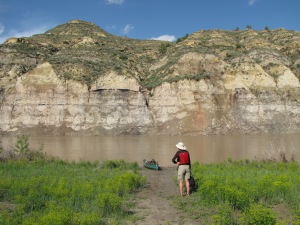The Little Missouri River had been on Tom’s bucket list for years. Arising near Devil’s Tower in eastern Wyoming, the river flows north through western North Dakota, carving out the badlands of Theodore Roosevelt National Park, before joining with the larger Missouri River northeast of the park. The Little Missouri’s flow is largely dependent on precipitation. It becomes unnavigable in summer, so several years ago, after a rainy May, we packed up and headed west on I-94. Now was the time to paddle the Little Missouri.
A sere, understated landscape greeted us. The water, we were surprised to see (Minnesotans seldom see water so turbidi), resembled a mocha latte. We put in 20 miles south of the national park with a plan to travel to its southern border, paddling through National Grassland most of the time. In early June, Western Meadowlarks piped continuously, a sweet, wild soundtrack to what seemed a Hollywood scene– you know: Dances with Wolves. The federally-owned land is grazed by cattle, but the first day, we did not see a single human being. The second day, our canoe was chased by an enthusiastic border collie Doing His Job.
I thought of our trip down the Little Missouri River this past week after hearing a segment on MPR on the loss of the night sky threatening the national park. As the oil boom expands at Williston, ND, directly north of Theodore Roosevelt, flares burn off the methane released in the pursuit of shale oil in the Bakken Formation. The dark sky and luminous Milky Way are lost, as night over the oil fields becomes brighter and brighter.
It’s a small environmental problem in the great scheme of things, and one that’s fixable. Humans have always used the vastness of night to understand our place in the Universe. We should not lose this yardstick at this time in our history.
